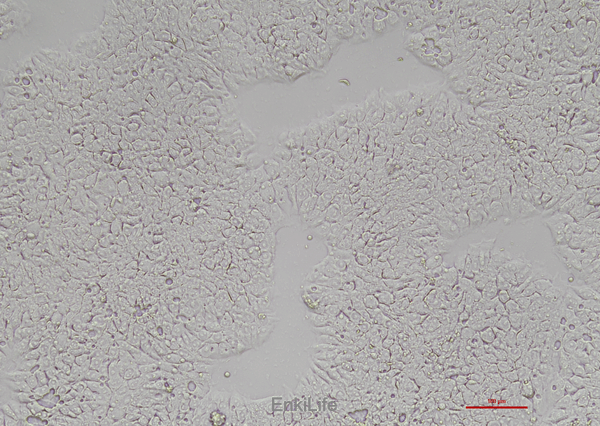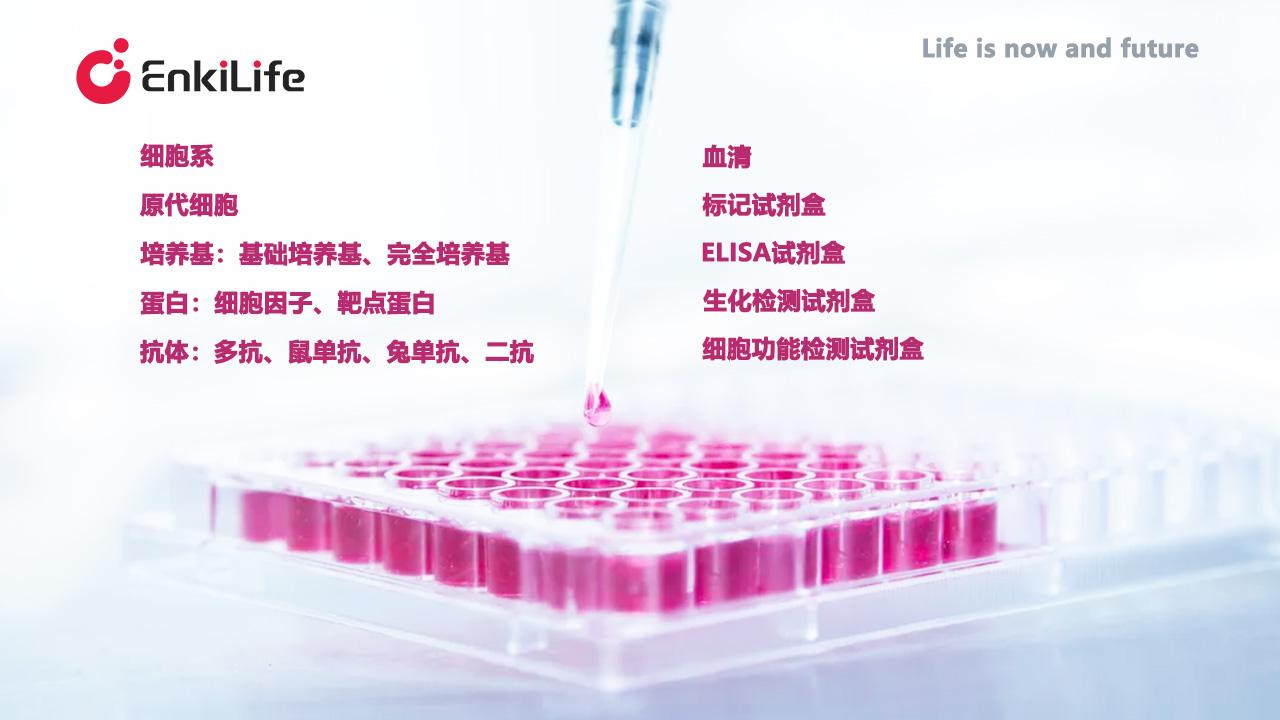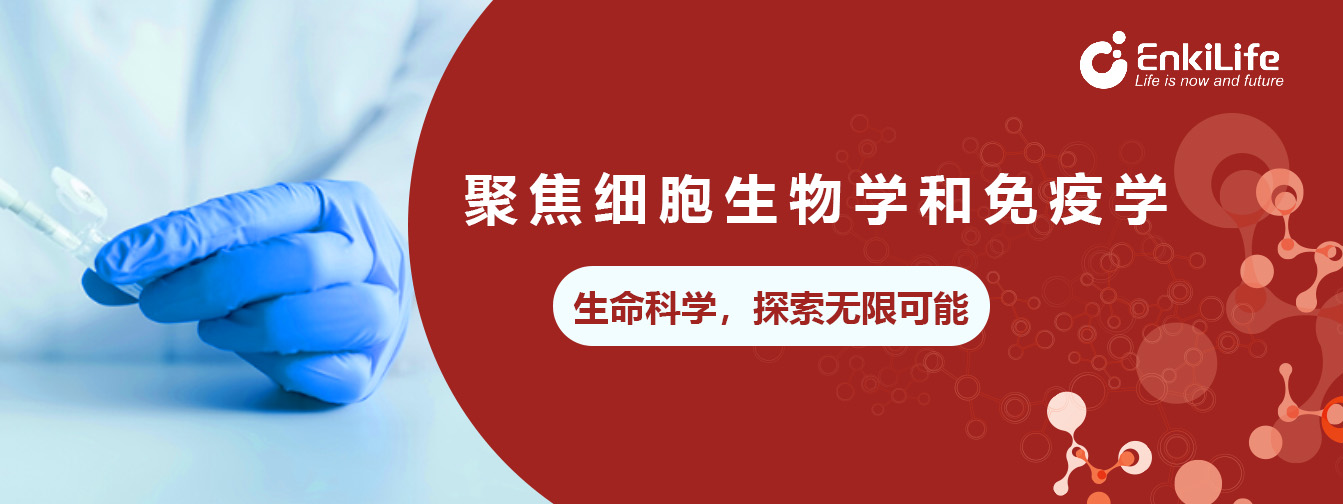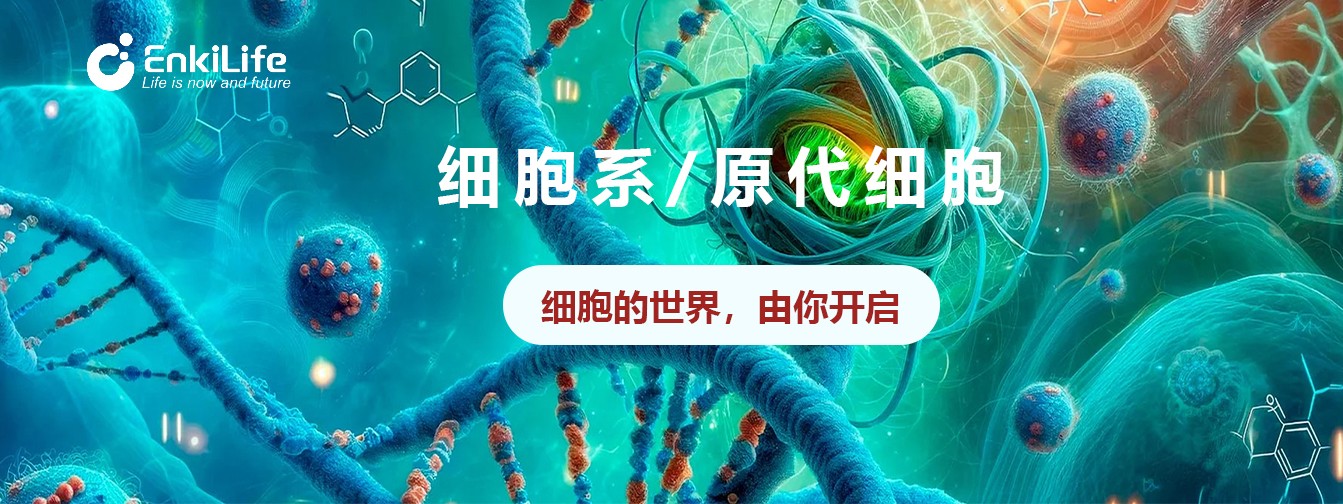人胚胎干细胞hESC(H1)
发表时间:2025-07-14人胚胎干细胞hESC(H1)
1. 细胞来源
(1)胚胎来源:hESC(H1)源自囊胚内细胞团(ICM),由Thomson团队于1998年首次从人类囊胚中分离建立[1]。
(2)其他来源:除正常受精囊胚外,亦可从低质量胚胎、废弃IVF/PGD胚胎(衍生率16.7%)及异常受精合子(如三原核胚胎)中成功建系[5][9][12]。

2. 生物学特性
(1)形态与增殖:细胞呈紧密集落状生长,核质比高,核仁明显;具无限自我更新能力。
(2)多能性标志物:高表达OCT4、NANOG、SSEA-4、TRA-1-60等干细胞标志物[1][4][16]。
(3)分化潜能:可分化为三胚层组织(如神经外胚层、软骨中胚层、肠管内胚层)及滋养层细胞[1][3][15]。
(4)遗传稳定性:长期培养可维持正常二倍体核型,但部分细胞系可能出现染色体异常(如13号三体)[4][9]。
(5)表观遗传特征:具有独特的X染色体失活模式及印记基因表达谱[9][14]。
3. 培养与储存
(1)传统培养体系:依赖小鼠胚胎成纤维细胞(MEFs)饲养层及胎牛血清(FBS),存在动物源性污染风险[10][19]。
(2)无饲养层体系:
人源饲养层(如胎盘成纤维细胞)或基质蛋白(如Matrigel)[6]。
无血清培养基(含KSR)及生长因子(bFGF、Activin A)[10][19]。
(3)关键技术突破:ROCK抑制剂Y-27632提升单细胞消化存活率[16];激光辅助囊胚孵出技术减少异源物质接触。
(4)储存方法:液氮冷冻保存,复苏后需验证多能性[19]。
4. 研究应用领域
(1)发育生物学:模拟人类早期胚胎发育及细胞命运决定机制[15][20]。
(2)疾病建模:构建遗传病模型(如染色体异常疾病),用于发病机制研究[9][11]。
(3)再生医学:定向分化为心肌细胞、肝细胞、神经元等,用于细胞替代治疗[8][17]。
(4)药物筛选:评估药物毒性及功效的平台[11][18]。
(5)免疫学研究:分化为造血细胞(如嗜碱性粒细胞),研究免疫应答机制[17]。
5. 近几年研究进展
(1)单细胞建系技术:从单个卵裂球成功衍生hESC,揭示滋养层分化新路径[15]。
(2)免疫原性解决方案:
HLA配型库建立(评估28个hESC系),降低移植排斥风险[8]。
诱导多能干细胞(iPSC)技术规避伦理问题[13]。
(3)无动物成分培养:成分明确培养基(如N2B27)实现临床级hESC扩增[10][16]。
(4)基因编辑应用:CRISPR技术修饰hESC,用于疾病机制研究及细胞治疗优化[11]。
6. 局限性与克服方法
(1)致瘤风险:移植后残留未分化细胞可能导致畸胎瘤。应对:严格分化纯度检测及自杀基因开关设计[8][11]。
(2)免疫排斥:异体移植需长期免疫抑制。应对:建立HLA匹配库或诱导免疫耐受[8][13]。
(3)培养标准化难题:不同培养条件影响细胞特性。应对:开发无饲养层/无异源成分标准化流程[10][19]。
(4)伦理法规限制:多国政策限制胚胎使用。应对:推广iPSC技术及废弃胚胎利用[5][11]。
7. 总结与展望
hESC(H1)作为多能性研究的核心工具,已在发育机制解析、疾病建模和再生医学中展现巨大潜力。未来需聚焦:
(1)临床应用安全化:完善GMP级生产标准及致瘤风险管控[18]。
(2)技术整合:结合类器官与单细胞测序,深化发育路径研究[15][20]。
(3)伦理创新:推动"非胚胎依赖"策略(如iPSC)[13]。
(4)跨学科合作:联合基因编辑与组织工程,实现精准细胞治疗[11][16]。

参考文献
1. Thomson JA, et al. Embryonic stem cell lines derived from human blastocysts. Science. 1998;282(5391):1145-1142. PMID: 9804553.
2. Evans MJ, Kaufman MH. Establishment in culture of pluripotential cells from mouse embryos. Nature. 1981;292(5819):154-153. PMID: 7242681.
3. Reubinoff BE, et al. Embryonic stem cell lines from human blastocysts: somatic differentiation in vitro. Nat Biotechnol. 2000;18(4):399-404. PMID: 10748515.
4. Heins N, et al. Derivation, Characterization, and Differentiation of Human Embryonic Stem Cells. Stem Cells. 2004;22(3):367-375. PMID: 15153616.
5. Fan Y, et al. Diploid, but not haploid, human embryonic stem cells can be derived from microsurgically repaired tripronuclear human zygotes. Cell Research. 2013;23(2):254-256. PMID: 23208420.
6. Genbacev O, et al. Serum-free derivation of human embryonic stem cell lines on human placental fibroblast feeders. Fertil Steril. 2005;83(5):1517-1527. PMID: 15866598.
7. 全松, 陈薪, 邢福祺. 人胚胎干细胞研究与展望. 中国组织工程研究与临床康复. 2007;11(40):8077-8080.
8. Lee JE, et al. Evaluation of 28 Human Embryonic Stem Cell Lines for Use as Unrelated Donors in Stem Cell Therapy: Implications of HLA and ABO Genotypes. Cell Transplant. 2010;19(11):1383-1399. PMID: 206989210.
9. Sun X, et al. Similar biological characteristics of human embryonic stem cell lines with normal and abnormal karyotypes. Hum Reprod. 2008;23(10):2185-21910. PMID: 186644711.
10. 陈厚良, 陈宇. 人胚胎干细胞培养体系的研究进展. 中国细胞生物学学报. 2014;36(12):1742-1748.
11. Findikli N. Human Embryonic Stem Cells from Laboratory and Clinical Perspectives. Stem Cell Rev. 2012;8(4):1151-1162. PMID: 22729853.
12. Amit M, Itskovitz-Eldor J. Methods for the Derivation of Human Embryonic Stem Cell Lines. Methods Mol Biol. 2012;873:1-13. PMID: 22528350.
13. Ljuji? B, Stojkovi? M. FOR DERIVATION OF HUMAN EMBRYONIC STEM CELLS. Arch Biol Sci. 2010;62(4):943-954.
14. Liu Y, et al. Genome wide profiling of human embryonic stem cells (hESCs), their derivatives and embryonal carcinoma cells to develop base profiles of U.S. Federal government approved hESC lines. BMC Dev Biol. 2006;6:20. PMID: 16670026.
15. Zdravkovic T, et al. Human Stem Cells from Single Blastomeres Reveal pathways of embryonic or trophoblast fate specification. Cell. 2014;158(3):722-736. PMID: 25126797.
16. 吴蓉蓉. 人胚胎干细胞建系,鉴定及分化为多能性间充质样前体细胞. 浙江大学博士学位论文. 2007.
17. 古彦铮. 人类胚胎干细胞/诱导性多能干细胞向成熟的嗜碱性粒细胞诱导分化及其生物学特性的研究. 浙江大学博士学位论文. 2018.
18. Fonseca SAS, et al. Human Embryonic Stem Cell Line Derivation. Methods Mol Biol. 2016;1516:1-19. PMID: 270139810.
19. Skottman H, Hovatta O. Culture conditions for human embryonic stem cells. Reproduction. 2006;132(5):691-6910. PMID: 17071771.
20. Dvash T, et al. Human Embryonic Stem Cells as a Powerful Tool for Studying Human Embryogenesis. Pediatr Res. 2006;60(2):111-117. PMID: 16864688.




